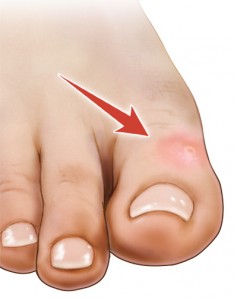Also called helomas, corns on our feet are the result of too much friction on the skin of a toe and too much pressure on the bone.
In most cases, ill-fitting shoes contribute to the problem. Thick skin forms to protect your feet, thanks to a defense mechanism built into your skin.
Corns affect people of all ages (except infants), and are seen most frequently in African Americans. If left untreated, they can grow to become large and painful.
There are two types of corns: hard and soft. Hard corns are more common and usually form on the top of the toe or on the side of your foot.
They are usually caused by improper footwear and toe deformities. Soft corns usually form in between the toes, where the moisture keeps them soft, and are caused by abnormalities of the toe bone or by shoes with narrow toe-boxes (high heels are one example).

Symptoms of Corns on Feet to Look For
Developing corns thicken the skin in the area where the corn is forming. The most common spot for them to appear is on the toes.
Corns are typically 3 mm to 10 mm in diameter and have a hard center. You may experience the following symptoms if you have a corn on your foot:
- Tenderness
- Thickness of skin
- Hardening of skin
- Irritation while wearing shoes
- Pain
Why Do I Have Corns on My Feet?
Corns are usually brought on by excessive friction and pressure, such as may be caused by ill-fitting shoes, although toe deformities can also cause corns to develop. When the skin is stimulated by friction and pressure, it automatically tries to protect itself.
The cells in the irritated area begin to grow at a faster rate, leading to an overgrowth. When the pressure and friction continue for a long time, large corns develop.
Should I See a Doctor for Corns on My Feet?
Anytime you feel you need a medical opinion you should see a doctor, regardless of your problem. No medication exists that cures corns, but there is medication to ease the symptoms. This is why it’s important to see a podiatrist if you are developing corns.
If self-treatment fails, or if there are signs of infection, contact your doctor immediately. Signs of infection include redness, pain, heat, tenderness, or swelling.
Diagnosing Corns on Feet — What to Expect
Most doctors will be able to diagnose corns on your feet with a simple physical examination. Occasionally skin biopsies and x-rays are taken to determine whether there are additional abnormalities in the foot and skin.
How Are Corns On My Feet Treated?
Treatment of corns usually begins with focusing on the cause of the problem, since corns do not always respond to medication. Stubborn corns are sometimes caused by anunderlying condition such as diabetes, which makes people more susceptible to corns, calluses, and blisters on the feet.
A person with diabetes or another disorder that causes poor circulation wouldn’t benefit from corn plasters. Corn plasters can sometimes even cause foot ulcers, which can complicate the situation further, possibly requiring amputation of the affected foot.
Common treatment options for corns on the feet include:
- Medication
- Corn paints
- Corn plasters
- Special orthotics to redistribute and transfer pressure on the foot
- Change in footwear; avoiding certain shoes such as high heels
- Antibiotics may be prescribed if there is an infection
- Cortisone drug injection to reduce swelling or pain
- Cut or burn off corn with topical acid solution (when other methods fail)
- Surgically remove the bone in the toe that is responsible for the corn
Here is another common way to eliminate corns:
- Peel the upper layers of the corn once or twice a day
- Apply a nonprescription 5% or 10% salicylic ointment after peeling
- Cover with adhesive tape
The goal of treatment is to reduce pressure and friction. This can be done in a number of ways, but your doctor will know which method is best for you. If the toe is not flexible, surgery may be performed to remove the corns.
Unfortunately, corns do not have a root to remove to prevent them from recurring. This is why it’s important to eliminate potential causes. With treatment, corns should not take more than a few weeks to disappear.
Can Corns on the Feet Be Prevented?
Here are some tips to help you prevent corns from developing on your feet:
- Always wear clean, dry socks.
- Avoid wearing shoes indoors.
- Avoid buying shoes that do not have a natural shape.
- Do not wear shoes that are tight around your toes.
- When trying on new shoes, pay attention to how the inside seams rub against your feet when you walk.
- Buy shoes with extra padding.
- Avoid activities that cause excessive friction and pressure.
- Keep your skin moisturized.
Talk with your doctor or podiatrist about recurrence of corns.
Talking to Your Doctor
Here are some questions you may want to ask your doctor about corns on your feet:
- After treatment begins, what symptoms should I watch for that may indicate that the corn is not healing?
- What over-the-counter products will work best for me?
- I’d like you to look at my footwear and tell me if they fit properly. Can I make another appointment to bring in my shoes?
- How severe are the corns on my feet?
- What type of athletic shoes would benefit me most?
- Will the treatment cause me to miss work or school?




